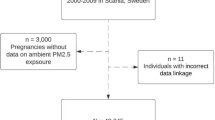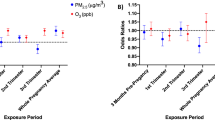Abstract
Background
Prenatal exposure to ambient air pollution and traffic have been related to a lower birth weight and may be associated with greater adiposity in childhood. We aimed to examine associations of maternal exposure to ambient air pollution and traffic during pregnancy with indicators of adiposity in early childhood.
Methods
We included 738 participants of the Colorado-based Healthy Start study whose height, weight, waist circumference and/or fat mass were measured at age 4–6 years. We estimated residential exposure to ambient concentrations of fine particulate matter (PM2.5) and ozone (O3) averaged by trimester and throughout pregnancy via inverse distance-weighted interpolation of central site monitoring data. We assessed the distance to the nearest major roadway and traffic density in multiple buffers surrounding the participants’ homes. Associations of prenatal exposure to air pollution and traffic with overweight, waist circumference, percent fat mass and fat mass index (FMI) were assessed by logistic and linear regression.
Results
Associations of exposure to PM2.5 and O3 at the residential address during pregnancy with percent fat mass and FMI at age 4–6 years were inconsistent across trimesters. For example, second trimester PM2.5 was associated with a higher percent fat mass (adjusted difference 0.70% [95% CI 0.05, 1.35%] per interquartile range (IQR; 1.3 µg/m3) increase), while third trimester PM2.5 was associated with a lower percent fat mass (adjusted difference −1.17% [95% CI −1.84, −0.50%] per IQR (1.3 µg/m3) increase). Residential proximity to a highway during pregnancy was associated with higher odds of being overweight at age 4–6 years. We observed no associations of prenatal exposure to PM2.5 and O3 with overweight and waist circumference.
Conclusions
We found limited evidence of associations of prenatal exposure to ambient PM2.5 and O3 with indicators of adiposity at age 4–6 years. Suggestive relationships between residential proximity to a highway during pregnancy and greater adiposity merit further investigation.
This is a preview of subscription content, access via your institution
Access options
Subscribe to this journal
Receive 12 print issues and online access
$259.00 per year
only $21.58 per issue
Buy this article
- Purchase on Springer Link
- Instant access to full article PDF
Prices may be subject to local taxes which are calculated during checkout
Similar content being viewed by others
References
Adair LS. Child and adolescent obesity: epidemiology and developmental perspectives. Physiol Behav. 2008;94:8–16.
Dietz WH. Periods of risk in childhood for the development of adult obesity-what do we need to learn? J Nutr. 1997;127:1884S–6S.
Zheng T, Zhang J, Sommer K, Bassig BA, Zhang X, Braun J, et al. Effects of environmental exposures on fetal and childhood growth trajectories. Ann Glob Health. 2016;82:41–99.
Russ K, Howard S. Developmental exposure to environmental chemicals and metabolic changes in children. Curr Probl Pediatr Adolesc Health Care. 2016;46:255–85.
Li X, Huang S, Jiao A, Yang X, Yun J, Wang Y, et al. Association between ambient fine particulate matter and preterm birth or term low birth weight: An updated systematic review and meta-analysis. Environ Pollut. 2017;227:596–605.
Pedersen M, Giorgis-Allemand L, Bernard C, Aguilera I, Andersen AM, Ballester F, et al. Ambient air pollution and low birthweight: a European cohort study (ESCAPE). Lancet Respir Med. 2013;1:695–704.
Dadvand P, Parker J, Bell ML, Bonzini M, Brauer M, Darrow LA, et al. Maternal exposure to particulate air pollution and term birth weight: a multi-country evaluation of effect and heterogeneity. Environ Health Perspect. 2013;121:267–373.
Kingsley SL, Eliot MN, Glazer K, Awad YA, Schwartz JD, Savitz DA, et al. Maternal ambient air pollution, preterm birth and markers of fetal growth in Rhode Island: results of a hospital-based linkage study. J Epidemiol Community Health. 2017;71:1131–6.
Malmqvist E, Liew Z, Kallen K, Rignell-Hydbom A, Rittner R, Rylander L, et al. Fetal growth and air pollution - a study on ultrasound and birth measures. Environ Res. 2017;152:73–80.
Martin A, Connelly A, Bland RM, Reilly JJ. Health impact of catch-up growth in low-birth weight infants: systematic review, evidence appraisal, and meta-analysis. Matern Child Nutr. 2017;13:e12297.
Baird J, Fisher D, Lucas P, Kleijnen J, Roberts H, Law C. Being big or growing fast: systematic review of size and growth in infancy and later obesity. BMJ. 2005;331:929.
Perng W, Hajj H, Belfort MB, Rifas-Shiman SL, Kramer MS, Gillman MW, et al. Birth size, early life weight gain, and midchildhood cardiometabolic health. J Pediatr. 2016;173:122–30 e1.
Kannan S, Misra DP, Dvonch JT, Krishnakumar A. Exposures to airborne particulate matter and adverse perinatal outcomes: a biologically plausible mechanistic framework for exploring potential effect modification by nutrition. Environ Health Perspect. 2006;114:1636–42.
Fleisch AF, Luttmann-Gibson H, Perng W, Rifas-Shiman SL, Coull BA, Kloog I, et al. Prenatal and early life exposure to traffic pollution and cardiometabolic health in childhood. Pediatr Obes. 2017;12:48–57.
Mao G, Nachman RM, Sun Q, Zhang X, Koehler K, Chen Z, et al. Individual and joint effects of early-life ambient PM2.5 exposure and maternal prepregnancy obesity on childhood overweight or obesity. Environ Health Perspect. 2017;125:067005.
Chiu YM, Hsu HL, Wilson A, Coull BA, Pendo MP, Baccarelli A, et al. Prenatal particulate air pollution exposure and body composition in urban preschool children: Examining sensitive windows and sex-specific associations. Environ Res. 2017;158:798–805.
Huang JV, Leung GM, Schooling CM. The association of air pollution with body mass index: evidence from Hong Kong’s “Children of 1997” birth cohort. Int J Obes (Lond). 2019;43:62–72.
Kim E, Park H, Park EA, Hong YC, Ha M, Kim HC, et al. Particulate matter and early childhood body weight. Environ Int. 2016;94:591–9.
Rundle A, Hoepner L, Hassoun A, Oberfield S, Freyer G, Holmes D, et al. Association of childhood obesity with maternal exposure to ambient air polycyclic aromatic hydrocarbons during pregnancy. Am J Epidemiol. 2012;175:1163–72.
Sears CG, Mueller-Leonhard C, Wellenius GA, Chen A, Ryan P, Lanphear BP, et al. Early-life exposure to traffic-related air pollution and child anthropometry. Environmental Epidemiology. 2019;3:e061.
Kim JS, Alderete TL, Chen Z, Lurmann F, Rappaport E, Habre R, et al. Longitudinal associations of in utero and early life near-roadway air pollution with trajectories of childhood body mass index. Environ Health. 2018;17:64.
Fleisch AF, Aris IM, Rifas-Shiman SL, Coull BA, Luttmann-Gibson H, Koutrakis P, et al. Prenatal exposure to traffic pollution and childhood body mass index trajectory. Front Endocrinol. 2019;9:771.
Rosofsky AS, Fabian MP, Ettinger de Cuba S, Sandel M, Coleman S, Levy JI. et al. Prenatal ambient particulate matter exposure and longitudinal weight growth trajectories in early childhood. Int J Environ Res Public Health. 2020;17:1444.
Fossati S, Valvi D, Martinez D, Cirach M, Estarlich M, Fernandez-Somoano A, et al. Prenatal air pollution exposure and growth and cardio-metabolic risk in preschoolers. Environ Int. 2020;138:105619.
Javed A, Jumean M, Murad MH, Okorodudu D, Kumar S, Somers VK, et al. Diagnostic performance of body mass index to identify obesity as defined by body adiposity in children and adolescents: a systematic review and meta-analysis. Pediatr Obes. 2015;10:234–44.
Savva SC, Tornaritis M, Savva ME, Kourides Y, Panagi A, Silikiotou N, et al. Waist circumference and waist-to-height ratio are better predictors of cardiovascular disease risk factors in children than body mass index. Int J Obes Relat Metab Disord. 2000;24:1453–8.
Janssen I, Katzmarzyk PT, Ross R. Waist circumference and not body mass index explains obesity-related health risk. Am J Clin Nutr. 2004;79:379–84.
Schmidt MD, Dwyer T, Magnussen CG, Venn AJ. Predictive associations between alternative measures of childhood adiposity and adult cardio-metabolic health. Int J Obes. 2011;35:38–45.
Colorado Department of Public Health & Environment. History of ozone in Colorado. https://www.colorado.gov/pacific/cdphe/ozone-planning-chronology.
Bell ML, Dominici F, Ebisu K, Zeger SL, Samet JM. Spatial and temporal variation in PM(2.5) chemical composition in the United States for health effects studies. Environ Health Perspect. 2007;115:989–95.
Starling AP, Moore BF, Thomas DSK, Peel JL, Zhang W, Adgate JL, et al. Prenatal exposure to traffic and ambient air pollution and infant weight and adiposity: The Healthy Start study. Environ Res. 2020;182:109130.
Centers for Disease Control and Prevention. Defining Childhood Obesity. https://www.cdc.gov/obesity/childhood/defining.html.
Fields DA, Allison DB. Air-displacement plethysmography pediatric option in 2-6 years old using the four-compartment model as a criterion method. Obesity. 2012;20:1732–7.
Wells JCK. A critique of the expression of paediatric body composition data. Arch Dis Child. 2001;85:67–72.
Wells JCK, Cole TJ.ALSPAC study steam Adjustment of fat-free mass and fat mass for height in children aged 8 y. Int J Obes Relat Metab Disord. 2002;26:947–52.
Wood S Package ‘mgcv’. 2021. https://cran.r-project.org/web/packages/mgcv/mgcv.pdf.
Salam MT, Millstein J, Li YF, Lurmann FW, Margolis HG, Gilliland FD. Birth outcomes and prenatal exposure to ozone, carbon monoxide, and particulate matter: results from the Children’s Health Study. Environ Health Perspect. 2005;113:1638–44.
Fleisch AF, Rifas-Shiman SL, Koutrakis P, Schwartz JD, Kloog I, Melly S, et al. Prenatal exposure to traffic pollution: associations with reduced fetal growth and rapid infant weight gain. Epidemiology. 2015;26:43–50.
Cunningham FG, Leveno KJ, Bloom SL, Dashe JS, Hoffman BL, Casey BM, et al. Williams obstetrics, 25th edition. McGraw-Hill Education; United States of America. 2018.
Chodick G, Flash S, Deoitch Y, Shalev V. Seasonality in birth weight: review of global patterns and potential causes. Hum Biol. 2009;81:463–77.
Strand LB, Barnett AG, Tong S. The influence of season and ambient temperature on birth outcomes: a review of the epidemiological literature. Environ Res. 2011;111:451–62.
An R, Wang J, Ashrafi SA, Yang Y, Guan C. Chronic noise exposure and adiposity: a systematic review and meta-analysis. Am J Prev Med. 2018;55:403–11.
Wang Z, Zhao L, Huang Q, Hong A, Yu C, Xiao Q. et al. Traffic-related environmental factors and childhood obesity: a systematic review and meta-analysis. Obes Rev. 2021;22:e12995
Jia P, Xue H, Cheng X, Wang Y, Wang Y. Association of neighborhood built environments with childhood obesity: evidence from a 9-year longitudinal, nationally representative survey in the US. Environ Int. 2019;128:158–64.
Tian N, Xue J, Barzyk TM. Evaluating socioeconomic and racial differences in traffic-related metrics in the United States using a GIS approach. J Expo Sci Environ Epidemiol. 2013;23:215–22.
Hajat A, Hsia C, O’Neill MS. Socioeconomic disparities and air pollution exposure: a global review. Curr Environ Health Rep. 2015;2:440–50.
Nethery E, Brauer M, Janssen P. Time-activity patterns of pregnant women and changes during the course of pregnancy. J Expo Sci Environ Epidemiol. 2009;19:317–24.
Chen L, Bell EM, Caton AR, Druschel CM, Lin S. Residential mobility during pregnancy and the potential for ambient air pollution exposure misclassification. Environ Res. 2010;110:162–8.
Lupo PJ, Symanski E, Chan W, Mitchell LE, Waller DK, Canfield MA, et al. Differences in exposure assignment between conception and delivery: the impact of maternal mobility. Paediatr Perinat Epidemiol. 2010;24:200–8.
Moss JL, Johnson NJ, Yu M, Altekruse SF, Cronin KA. Comparisons of individual- and area-level socioeconomic status as proxies for individual-level measures: evidence from the Mortality Disparities in American Communities study. Popul Health Metr. 2021;19:1.
Funding
This work was supported by grants from the National Institute of Environmental Health Sciences (R00ES025817), the National Institute of Diabetes and Digestive and Kidney Diseases (R01DK076648), and the National Institutes of Health Office of the Director (UH3OD023248). The content is solely the responsibility of the authors and does not necessarily represent the official views of the National Institutes of Health.
Author information
Authors and Affiliations
Contributions
APS and LDB designed the research question. LDB performed the statistical analyses, and LDB and APS interpreted the results. LDB drafted the first version of the manuscript. All authors reviewed and critically revised the manuscript. All authors read and approved the final version of the manuscript for submission. LDB takes responsibility for the contents of the manuscript.
Corresponding author
Ethics declarations
Competing interests
The authors declare no competing interests.
Additional information
Publisher’s note Springer Nature remains neutral with regard to jurisdictional claims in published maps and institutional affiliations.
Supplementary information
Rights and permissions
About this article
Cite this article
Bloemsma, L.D., Dabelea, D., Thomas, D.S.K. et al. Prenatal exposure to ambient air pollution and traffic and indicators of adiposity in early childhood: the Healthy Start study. Int J Obes 46, 494–501 (2022). https://doi.org/10.1038/s41366-021-01003-0
Received:
Revised:
Accepted:
Published:
Issue Date:
DOI: https://doi.org/10.1038/s41366-021-01003-0



